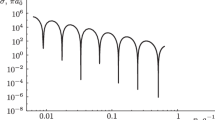Summary
The effect of the periodic potential and the residual Coulomb interaction on the inelastic scattering of light from pure electronic excitations in solids has been investigated by using the diagrammatic perturbation theory. It is shown that for a degenerate electron gas single-particle excitations with no spin reversals are heavily screened and almost all the scattering is from the collective plasma mode for momentum transfers small compared to Fermi-Thomas momentum. However, there is no screening of single-particle spin-density fluctuations. This is an important intra-band process for III–V semiconductors with an appreciable spin-orbit splitting of the valence band. For high concentration of carriers, the nonparabolicity of the band structure also contributes to the intra-band single-particle scattering. For low concentrations or at high temperatures, when plasma mode is no longer a well-defined normal mode of the system, these two processes are not important. In this case there is no screening of the single-particle excitations from electrons in a spherical parabolic band. For inter-band excitations, the effect of Coulomb interaction is shown to be negligible in the long-wavelength limit.
Riassunto
Usando la teoria diagrammatica delle perturbazioni si è studiato l’effetto del potenziale periodico e dell’interazione coulombiana residua sullo scattering anelastico della luce da parte di pure eccitazioni elettroniche nei solidi. Si dimostra che, per un gas di elettroni degenere, le eccitazioni di una singola particella senza inversione di spin sono fortemente schermate e quasi tutto lo scattering proviene dal modo collettivo del plasma per momenti trasferiti piccoli in confronto al momento di Fermi-Thomas. Invece non sono schermate le fluttuazioni della densità di spin di una singola particella. Questo è un importante processo intrabanda per semiconduttori III–V con una apprezzabile separazione spin-orbita della banda di valenza. Per alte concentrazioni dei portatori, la non parabolicità della struttura di banda contribuisce anche allo scattering intrabanda di una singola particella. Per basse concentrazioni o ad alte temperature, quando il modo del plasma non è un modo normale ben definito del sistema, questi due processi non sono importanti. In questo caso non vi è alcuna schermatura delle eccitazioni di una singola particella da parte degli elettroni in una banda parabolica sferica. Per eccitazioni interbanda, si dimostra che l’effetto dell’interazione di Coulomb è trascurabile nel limite delle grandi lunghezze d’onda.
Реэюме
Испольэуя диаграммную технику теории воэмушений, было исследовано влияние периодического потенциала и остаточного кулоновского вэаимодействия на неупругое рассеяние света на чисто злектронных воэбуждениях в твердых телах. Покаэывается, что для вырожденного злектронного гаэа, одночастичные воэбуждения беэ переворачивания спина являются сильно зкранированными, и почти всё рассеяние происходит на коллективной плаэменной моде для передаваемых импульсов, малых по сравнению с импульсом Томаса-Ферми. Однако, зкранирование отсутствует для одно-частичных колебаний с плотностью спина. Это представляет важный внутриэонный процесс для III–V полупроводников с эаметным спин-орбитальным расшеплением валентной эоны. Для высокой концентрации носителей, непараболичность эонной структуры также вносит вклад во внутриэонное одно-частичное рассеяние. Для малых концентраций и для высоких температур, когда плаэменная мода не длиннее, чем хорощо определенная нормальная мода системы, зти два процесса не являются важными. В зтом случае зкранирование отсутствует для одно-частичных воэбуждений для злектронов в сферической параболической эоне. Для междуэонных переходов покаэывается, что влияние кулоновского вэаимодействия является пренебрежимо малым в пределе больщих длин волн.
Similar content being viewed by others
References
A. Mooradian andG. B. Wright:Phys. Rev. Lett.,16, 999 (1966);A. Mooradian andA. L. McWhorter:Phys. Rev. Lett.,19, 849 (1967);C. K. N. Patel andR. E. Slusher:Phys. Rev.,167, 413 (1968).
A. Mooradian:Phys. Rev. Lett.,20, 1102 (1968).
M. N. Rosenbluth andN. Rostoker:Phys. Fluids,5, 776 (1962);A. Ron, J. Dawson andC. Oberman:Phys. Rev.,132, 497 (1963);E. E. Salpeter:Phys. Rev.,120, 1528 (1960).
P. M. Platzman:Phys. Rev.,139, A 379 (1965). See other references in this paper.
D. C. Dubois andV. Gilinski:Phys. Rev.,133, A 1308 (1964).
A. L. McWhorter: inPhysics of Quantum Electronics, edited byP. L. Kelley, B. Lax andP. E. Tannenwald (New York, 1966), p. 111.
P. A. Wolff:Phys. Rev. (to be published). See alsoP. A. Wolff:Phys. Rev. Lett.,16, 225 (1966).
M. Gell-Mann andK. A. Brueckner:Phys. Rev.,106, 364 (1957).
See for example,D. Pines:Elementary Excitations in Solids (New York, 964).
J. Lindhard:Kgl. Danske Videnskab. Selskab Mat. Fys. Medd.,28, 8 (1954);J. Hubbard:Proc. Roy. Soc., A243, 336 (1957);A. J. Glick:Ann. of Phys.,17, 61 (1962).
See the second paper in ref. (7).
It is more general to replace the nonparabolic term in eq. (3.20) by −(ħ 2/2m* √E G )2 BK 4, in which case eq. (3.22) has to be multiplied by a factorB 2. The numerical factorB describes the deviation of the spherical nonparabolic term from Kane’s model,Cardona (seeM. Cardona:Phys. Rev.,121, 752 (1961)) finds this factor to be of order 2 for GaAs which is also consistent with a recent third-order nonlinear optical mixing experiment ofJ. Wynne: private communication.
D. Bohm andD. Pines:Phys. Rev.,92, 609 (1953);P. Nozières andD. Pines:Nuovo Cimento,9, 470 (1958).
H. Ehrenreich andM. H. Cohen:Phys. Rev.,115, 786 (1959).
See, for example,C. Kittel:Quantum Theory of Solids, Chap. 6 (New York, 1963).
S. S. Jha:Phys. Rev.,150, 413 (1966). The effect of Coulomb interaction on the scattering amplitude, correct to second order in external vector potential has been explicitly considered in this paper. Some of our results may be derived from eq. (4.2) of this paper by making use of the total energy conservation and the transverse nature of our vector potential.
I would like to thank Dr.D. C. Hamilton for pointing out to me that one could explain Mooradian’s experimental data if one considered this process. He andA. L. McWhorter have calculated this process in detail, which will be published elsewhere.
E. O. Kane:Journ. Phys. Chem. Solids,1, 249 (1957).
Y. Yafet:Phys. Rev.,152, 858 (1966);P. L. Kelley andG. B. Wright:Bull. Am. Phys. Soc.,11, 812 (1966).
Author information
Authors and Affiliations
Additional information
This work was supported by the National Aeronautics and Space Administration Grant NGR 22-007-126.
Rights and permissions
About this article
Cite this article
Jha, S.S. Theory of light scattering from electronic excitations in solids. Nuovo Cimento B (1965-1970) 63, 331–354 (1969). https://doi.org/10.1007/BF02711064
Received:
Revised:
Published:
Issue Date:
DOI: https://doi.org/10.1007/BF02711064




